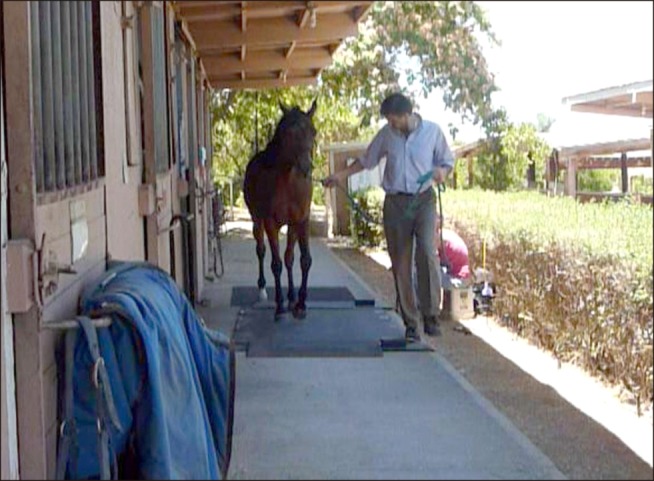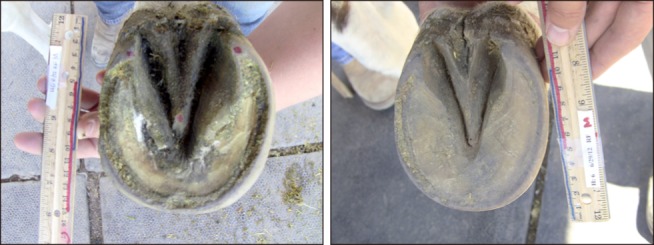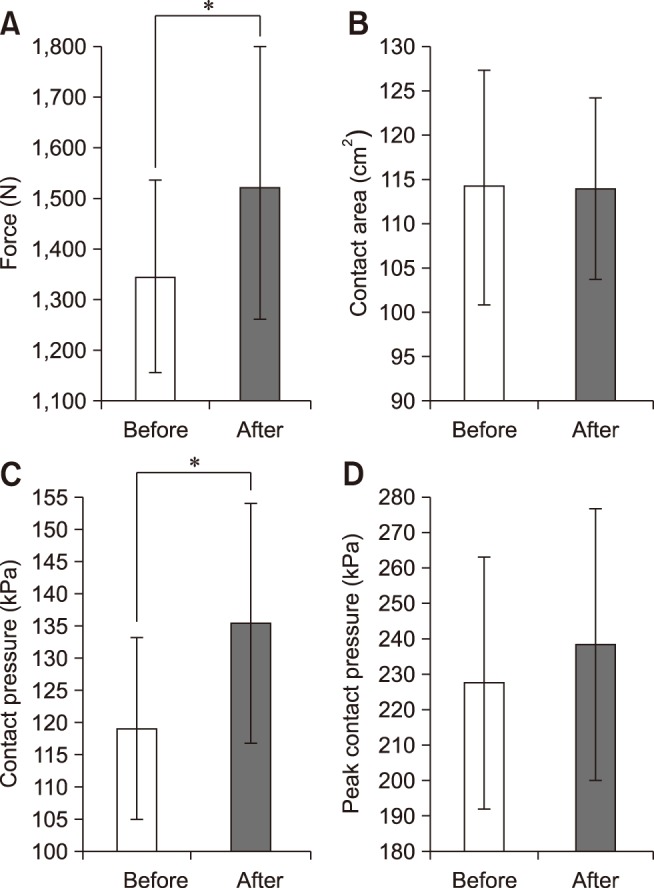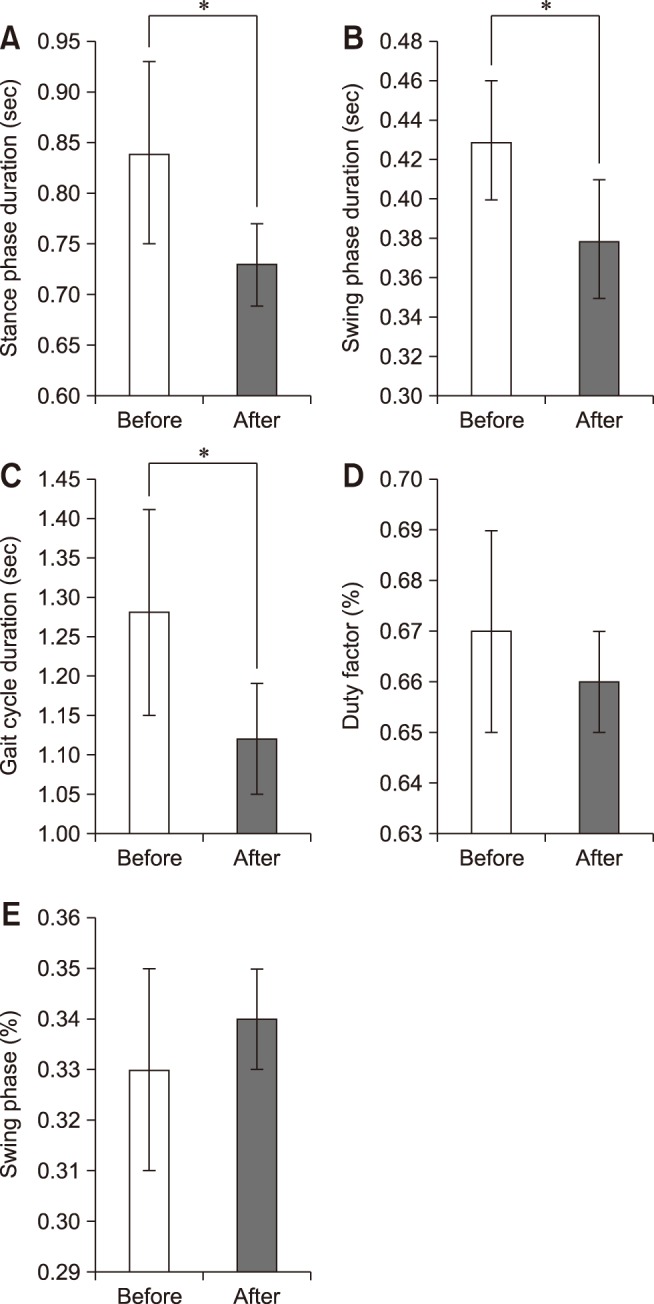Abstract
Appropriate hoof preparation and symmetry are linked to the well-being of the horse. Previous studies have shown the efficacy of pressure plates (PPs) in delivering objective biomechanical analysis. We aimed to assess the effect of hoof trimming on hoof biomechanics using a PP. Nine clinically sound Arabian horses were walked across a PP while foot strike was recorded by a digital camera. Kinetic and kinematic parameters were recorded before and after trimming. Changes were considered significant when p < 0.05. Vertical force (p = 0.026) and contact pressure (p = 0.006) increased after trimming. Stance-phase duration (p = 0.006), swing-phase duration (p = 0.023), and gait-cycle duration (p = 0.007) decreased significantly post-trimming. The observed changes in kinetic and kinematic parameters were related to hoof trimming. The reported results underline the importance of farriery practice and its effect on hoof biomechanics, which should be considered by both farriers and veterinarians.
Keywords: biomechanics, horses, kinematics, kinetics, pressure plate
Introduction
Maintaining hoof balance is essential for horses' soundness and performance [2]. Thus far, in daily practice, farriers and trimmers evaluate hoof balance by visual assessment, which is not flawless and, hence, may not provide a perfect assessment of hoof biomechanics. Farriers strive to maintain the optimum hoof balance by performing regular hoof care and trimming. While the trimming techniques and protocols may vary in different disciplines and among breeds, the goal is often the same: to preserve hoof balance. To date, trimming and shoeing techniques mostly rely on empiric craftsmanship rather than on evidence-based scientific approaches [7,38]. Information on the effect of routine farriery on internal structures and biomechanics of the equine foot is also limited [23]. Quantification of normal trimming and/or shoeing requires the use of sensitive measurement equipment [38]. Recent advances in gait and biomechanical analyses have provided several technologies to objectively evaluate hoof biomechanics; among those, pressure plates (PPs) are gaining more popularity in veterinary research and clinical settings [26,27].
PPs have been successfully used in humans [6,8,14,30,31,36], dogs [15,17,20,34], sheep [16], cows [4], cats [1,19,39], and horses [9,12,22,24,25,28,29,32,35,37,38]. A recent study compared the accuracy of force plates (FPs) and PPs, and the authors concluded that a PP was a precise alternative for use in a clinical setting [28]. While FPs have been used as the premiere benchmarks of capturing biometric data of hoof contact with the ground, several limitations apply. Because of the relatively small size of an FP, it can require many attempts to collect clear-cut data. Studies have shown that PPs can yield values similar to those of FPs [29]. The PPs may record data from simultaneous and consecutive hoof strikes as well as from different regions of the hoof [29]. Moreover, PPs are portable and can calculate pressure distribution as well. Our objective was to assess the effect of hoof trimming on hoof biomechanics by using a PP system that provides high resolution with high spatial accuracy. We hypothesized that none of the following parameters would change at midstance in response to routine trimming of the hoof: vertical force, pressure, contact area, peak pressure, stance-phase duration, swing-phase duration, gait-cycle duration, duty factor, and swing-phase.
Materials and Methods
Animals
Nine clinically sound Arabian horses (5 mares and 4 geldings) were used in this study. Their average withers height was 152 ± 5 cm and the average age was 5.9 ± 3.1 years. The horses were housed in stalls, regularly exercised, and received regular hoof trimming and shoeing at 6-week intervals. Their shoes were removed before the experiment; they were again shod by the same farrier at the conclusion of the experiment. The study was approved by the Western University of Health Sciences Animal Care and Use Committee (R 11/ACUC/022), and horse owners provided consent for the use of their animals.
Measurement systems and data collection
The PP used in this study was 2.1 m × 0.8 m in size and utilized approximately 18,000 force-sensitive, bendable resistors (Walkway; Tekscan, USA) and has been successfully used in previous human and veterinary biomechanical studies [5,10,11,17,21,40]. Using USB connections, the PP was connected to a laptop equipped with Walkway 7.0 software (Tekscan), and data were collected at 100 Hz. To provide adequate grip and protection for the sensors and to avoid slipping, the PP was covered with a thin, soft rubber mat approximately 2.5 m × 1 m in size and 5 mm in thickness, as recommended by the manufacturer (Fig. 1). The PP was calibrated according to the manufacturer's specifications by placing a person with known weight across the PP and manually inputting that weight into the Walkway software.
Fig. 1. A horse being walked on the pressure plate during a preliminary trial. The plate is covered with a thin rubber mat for plate protection and is connected to a laptop to collect data.

Each horse was walked over the PP to warm up and to allow them to familiarize themselves with the equipment. This process was helpful in reducing the horses' stress and avoiding abnormal gait. An experienced handler guided the horses across the PP at a velocity of 1.3 to 1.5 m/sec. A digital camera was positioned alongside the PP, and foot strike and gait were recorded (Cannon VIX-AF200; Canon, USA). A valid trial consisted of the horse walking in a straight line across the PP at a constant pace without a misstep. At least five valid trials were performed per horse for both the before- and after-trimming experiments. Once the before-trimming trials were completed, the farrier trimmed the hooves of each horse, and the horses were led across the PP a second time to record the after-trimming trial data (Fig. 2). The acclimation period (the time between the before- and after-trimming data collection) was limited to two hours based on results in a previous study [13]. Measurements were saved and analyzed at a later date. The same experienced farrier trimmed the hooves of all horses by applying routine farriery techniques; no corrective or therapeutic trimming was done.
Fig. 2. Solar view pictures of the same hoof before (A) and after (B) trimming.

Kinetic measurements
For both right forelimb (RF) and left forelimb (LF), the following kinetic measurements were collected at midstance before and after trimming: vertical force (N), which was normalized to the horses' body weight; contact area (cm2); contact pressure (kPa); and peak contact pressure (kPa).
Kinematic measurements
The following parameters were measured for both forelimbs before and after trimming: stance-phase duration was measured in seconds (sec) and defined as the time duration from impact to toe-off; swing-phase duration (sec) was measured as the time duration between break-over and impact of the next step of the same hoof; gait-cycle duration (sec) was calculated as stance-phase duration plus swing-phase duration; duty factor was defined as the percentage of stance-phase duration divided by gait-cycle duration; and swing phase was calculated as the percentage of swing-phase divided by gait-cycle duration.
Statistical analysis
Data preparation and descriptive statistic derivation were performed by using spreadsheet software (Microsoft Excel 2010; Microsoft, USA). Initially, the statistical difference between the left and right feet data was investigated by using the independent t-test. Kinetic parameters were examined by using the Wilcoxon signed-rank test. Kinematic data were normally distributed; a paired sample t-test was used to compare before- and after-trimming data. Statistical analyses were performed by using SAS software for Windows (ver. 9.3; SAS Institute, USA), and p values of ≤ 0.05 were considered significant.
Results
No statistically significant difference in kinematic and kinetic parameters between left and right hooves was detected; thus, a composite outcome was created by averaging both left and right hoof measures. Changes in measured kinetic parameters before and after trimming are shown in Fig. 3. Among the kinetic parameters, vertical force and contact pressure changed significantly after trimming: vertical force increased by 13% (p = 0.026), and contact pressure increased by 14% (p = 0.006). Contact area (p = 0.958) and peak contact pressure (p = 0.376) did not vary significantly. The changes in kinematic parameters before and after trimming are shown in Fig. 4. Stance-phase duration (p = 0.006), swing-phase duration (p = 0.023), and consequently, gait-cycle duration (p = 0.007) decreased significantly (by approximately 12%) after trimming. Duty factor and swing-phase after trimming did not change significantly (p = 0.77 and p = 1.00, respectively).
Fig. 3. Mean and SD of kinetic variables: force (A), contact area (B), contact pressure (C), and peak contact pressure (D) before and after hoof trimming. The asterisks indicate statistically significant changes in force and contact pressure.

Fig. 4. Mean and SD of kinematic variables: stance-phase duration (A), swing-phase duration (B), gait-cycle duration (C), duty factor (D), and swing-phase (E) before and after hoof trimming. The asterisks indicate statistically significant changes in stance-phase, swing-phase, and gait-cycle durations.

Discussion
The data showed significant changes in kinetic and kinematic parameters following hoof trimming; namely, vertical force and contact pressure increased, whereas the kinematic parameters of stance-phase, swing-phase, and gait-cycle duration decreased following trimming. To ensure consistency of data collection, each horse was tested several times, and data from a minimum of five valid trials were recorded. To avoid any immediate influence on horses' gaits, none of the horses were sedated for trimming. The hooves were trimmed by applying a routine farriery technique performed by the same farrier with no additional manipulations or excessive trimming. Discussing the different styles of hoof trimming is beyond the scope of this paper; however, the effect, or lack thereof, of inter-farrier trimming techniques on hoof biomechanical responses has yet to be investigated [7,33]. It has been shown that trimming may result in significant changes in hoof conformation [18,38]. The changes in force and contact pressure reported in this study are likely to be related to changes in post-trimming hoof conformation. In addition, it has been stated that trimming may affect the sensory perception of tactile or proprioceptive sensations [3]. Our results showed a significant increase in vertical force and contact pressure in response to trimming. In general, hoof trimming aims to level and balance the solar surface of the hoof; this can potentially alter the sensory perception of the hoof contact with the soft substrate mat. By using Doppler ultrasound technology, it has been shown that proper contact with the surface may improve foot vascular perfusion [3]. It is possible that changes in hoof conformation after trimming improved the force and pressure distribution.
Stride length was not measured in this study; however, since velocities were comparable, and gait-cycle duration decreased after trimming, it can be concluded that stride length might have been decreased after trimming as well. A previous study also found a decrease in duration of landing after trimming [38].
The results of this study provide an insight into kinetic and kinematic responses to routine hoof trimming. The horses used in this study were client-owned, from one farm, and trained by the same trainer under a similar training regimen and, therefore, may be a better representation of routine living condition of the general horse population than that of academic herds. However, the study had some limitations; for example, weighing the horses in a farm setting to record body mass and the addition of a control group were not feasible. Moreover, the horses were selected from one breed and one discipline; whether the results may vary in different breeds or in horses from different disciplines has yet to be investigated. To protect the PP, it was covered with a thin rubber mat; it is possible that the rubber mat had some dampening effect and caused the measured force or contact pressure to decrease slightly. However, since the same protocol was used for both the before- and after-trimming data collection, such dampening effect of the rubber mat on the comparison of the data, if any, would be trivial. The horses were examined within two hours of trimming, and whether a longer acclimation period or different or more aggressive trimming may result in different outcomes warrants further research. A previous study reported a difference in gait pattern between male and female cats and concluded that the difference was largely attributed to the larger size of the male cats [39]. Despite such differences in other species, the size of male and female horses are not significantly different, so a gender effect is less likely; regardless, more investigation is needed.
Previous scientific reports on the detailed effects of trimming on hoof kinetics and kinematics are scarce. This study used PP measurements to examine the kinetic and kinematic responses to routine hoof trimming in horses and provides an inchoate dataset for consideration in future studies. Our results showed significant changes in several biomechanical parameters following hoof trimming and specified the effect of hoof trimming on hoof biomechanics.
Acknowledgments
The authors would like to thank the Arabian Horse Foundation and Western University of Health Sciences for supporting this study. The authors wish to thank Mr. Scott Reeves for providing the horses and facility, Fion Hung, Michelle Crupi, Alexander Davis, William Jolley, and Fred Li for assistance with data collection.
Footnotes
Conflict of Interest: The authors declare no conflicts of interest.
References
- 1.Addison ES, Clements DN. Repeatability of quantitative sensory testing in healthy cats in a clinical setting with comparison to cats with osteoarthritis. J Feline Med Surg. 2017;19:1274–1282. doi: 10.1177/1098612X17690653. [DOI] [PMC free article] [PubMed] [Google Scholar]
- 2.Balch O, White K, Butler D, Metcalf S. Hoof balance and lameness: improper toe length, hoof angle, and mediolateral balance. Compend Contin Educ Pract Vet. 1995;17:1275–1283. [Google Scholar]
- 3.Bowker RM, Isbell D, Lancaster LS, Leonhardt W. The horse's foot as a neurosensory organ: how the horse perceives its environment. In: Ramey P, editor. Care and Rehabilitation of the Equine Foot. Lakemont: Hoof Rehabilitation Publishing; 2011. pp. 98–133. [Google Scholar]
- 4.Carvalho VRC, Bucklin RA, Shearer JK, Shearer L. Effects of trimming on dairy cattle hoof weight bearing and pressure distributions during the stance phase. Trans ASAE. 2005;48:1653–1659. [Google Scholar]
- 5.Coda A, Carline T, Santos D. Repeatability and reproducibility of the Tekscan HR-Walkway system in healthy children. Foot (Edinb) 2014;24:49–55. doi: 10.1016/j.foot.2014.02.004. [DOI] [PubMed] [Google Scholar]
- 6.Costa ML, Kay D, Donell ST. Gait abnormalities following rupture of the tendo Achillis: a pedobarographic assessment. J Bone Joint Surg Br. 2005;87:1085–1088. doi: 10.1302/0301-620X.87B8.16540. [DOI] [PubMed] [Google Scholar]
- 7.Eliashar E. An evidence-based assessment of the biomechanical effects of the common shoeing and farriery techniques. Vet Clin North Am Equine Pract. 2007;23:425–442. doi: 10.1016/j.cveq.2007.03.010. [DOI] [PubMed] [Google Scholar]
- 8.Fernández-Seguin LM, Diaz Mancha JA, Sánchez Rodríguez R, Escamilla Martínez E, Gómez Martín B, Ramos Ortega J. Comparison of plantar pressures and contact area between normal and cavus foot. Gait Posture. 2014;39:789–792. doi: 10.1016/j.gaitpost.2013.10.018. [DOI] [PubMed] [Google Scholar]
- 9.Fürst A, Galuppo LD, Judy CE, Auer J, Snyder JR. Evaluation of the Tekscan F-SCAN system for measurement of the kicking force in horses. Schweiz Arch Tierheilkd. 2016;158:623–629. doi: 10.17236/sat00082. [DOI] [PubMed] [Google Scholar]
- 10.Goetz JE, Coleman MC, Fredericks DC. Time-dependent loss of mitochondrial function precedes progressive histologic cartilage degeneration in a rabbit meniscal destabilization model. J Orthop Res. 2017;35:590–599. doi: 10.1002/jor.23327. [DOI] [PMC free article] [PubMed] [Google Scholar]
- 11.Goetz JE, Fredericks D, Petersen E, Rudert MJ, Baer T, Swanson E, Roberts N, Martin J, Tochigi Y. A clinically realistic large animal model of intra-articular fracture that progresses to post-traumatic osteoarthritis. Osteoarthritis Cartilage. 2015;23:1797–1805. doi: 10.1016/j.joca.2015.05.022. [DOI] [PubMed] [Google Scholar]
- 12.Gorissen BMC, Wolschrijn CF, Serra Bragança FM, Geerts AAJ, Leenders WOJL, Back W, van Weeren PR. The development of locomotor kinetics in the foal and the effect of osteochondrosis. Equine Vet J. 2017;49:467–474. doi: 10.1111/evj.12649. [DOI] [PMC free article] [PubMed] [Google Scholar]
- 13.Hood DM, Taylor D, Wagner IP. Effects of ground surface deformability, trimming, and shoeing on quasistatic hoof loading pattern in horses. Am J Vet Res. 2001;62:895–900. doi: 10.2460/ajvr.2001.62.895. [DOI] [PubMed] [Google Scholar]
- 14.Izquierdo-Renau M, Pérez-Soriano P, Ribas-García V, Queralt A. Intra and intersession repeatability and reliability of the S-Plate® pressure platform. Gait Posture. 2017;52:224–226. doi: 10.1016/j.gaitpost.2016.12.001. [DOI] [PubMed] [Google Scholar]
- 15.Jevens DJ, DeCamp CE, Hauptman J, Braden TD, Richter M, Robinson R. Use of force-plate analysis of gait to compare two surgical techniques for treatment of cranial cruciate ligament rupture in dogs. Am J Vet Res. 1996;57:389–393. [PubMed] [Google Scholar]
- 16.Kim J, Breur GJ. Temporospatial and kinetic characteristics of sheep walking on a pressure sensing walkway. Can J Vet Res. 2008;72:50–55. [PMC free article] [PubMed] [Google Scholar]
- 17.Kim J, Kazmierczak KA, Breur GJ. Comparison of temporospatial and kinetic variables of walking in small and large dogs on a pressure-sensing walkway. Am J Vet Res. 2011;72:1171–1177. doi: 10.2460/ajvr.72.9.1171. [DOI] [PubMed] [Google Scholar]
- 18.Kummer M, Geyer H, Imboden I, Auer J, Lischer C. The effect of hoof trimming on radiographic measurements of the front feet of normal warmblood horses. Vet J. 2006;172:58–66. doi: 10.1016/j.tvjl.2005.03.008. [DOI] [PubMed] [Google Scholar]
- 19.Lascelles BD, Findley K, Correa M, Marcellin-Little D, Roe S. Kinetic evaluation of normal walking and jumping in cats, using a pressure-sensitive walkway. Vet Rec. 2007;160:512–516. doi: 10.1136/vr.160.15.512. [DOI] [PubMed] [Google Scholar]
- 20.Light VA, Steiss JE, Montgomery RD, Rumph PF, Wright JC. Temporal-spatial gait analysis by use of a portable walkway system in healthy Labrador Retrievers at a walk. Am J Vet Res. 2010;71:997–1002. doi: 10.2460/ajvr.71.9.997. [DOI] [PubMed] [Google Scholar]
- 21.Makagon MM, Woolley R, Karcher DM. Assessing the waddle: an evaluation of a 3-point gait score system for ducks. Poult Sci. 2015;94:1729–1734. doi: 10.3382/ps/pev151. [DOI] [PubMed] [Google Scholar]
- 22.Merkens HW, Schamhardt HC, Van Osch GJ, Van den Bogert AJ. Ground reaction force patterns of Dutch warmblood horses at normal trot. Equine Vet J. 1993;25:134–137. doi: 10.1111/j.2042-3306.1993.tb02923.x. [DOI] [PubMed] [Google Scholar]
- 23.Moleman M, van Heel MC, van Weeren PR, Back W. Hoof growth between two shoeing sessions leads to a substantial increase of the moment about the distal, but not the proximal, interphalangeal joint. Equine Vet J. 2006;38:170–174. doi: 10.2746/042516406776563242. [DOI] [PubMed] [Google Scholar]
- 24.Nauwelaerts S, Hobbs SJ, Back W. A horse's locomotor signature: COP path determined by the individual limb. PLoS One. 2017;12:e0167477. doi: 10.1371/journal.pone.0167477. [DOI] [PMC free article] [PubMed] [Google Scholar]
- 25.Oomen AM, Oosterlinck M, Pille F, Sonneveld DC, Gasthuys F, Back W. Use of a pressure plate to analyse the toe-heel load redistribution underneath a normal shoe and a shoe with a wide toe in sound warmblood horses at the walk and trot. Res Vet Sci. 2012;93:1026–1031. doi: 10.1016/j.rvsc.2012.01.010. [DOI] [PubMed] [Google Scholar]
- 26.Oosterlinck M, Bosmans T, Gasthuys F, Polis I, Van Ryssen B, Dewulf J, Pille F. Accuracy of pressure plate kinetic asymmetry indices and their correlation with visual gait assessment scores in lame and nonlame dogs. Am J Vet Res. 2011;72:820–825. doi: 10.2460/ajvr.72.6.820. [DOI] [PubMed] [Google Scholar]
- 27.Oosterlinck M, Hardeman LC, van der Meij BR, Veraa S, van der Kolk JH, Wijnberg ID, Pille F, Back W. Pressure plate analysis of toe-heel and medio-lateral hoof balance at the walk and trot in sound sport horses. Vet J. 2013;198(Suppl 1):e9–e13. doi: 10.1016/j.tvjl.2013.09.026. [DOI] [PubMed] [Google Scholar]
- 28.Oosterlinck M, Pille F, Back W, Dewulf J, Gasthuys F. Use of a stand-alone pressure plate for the objective evaluation of forelimb symmetry in sound ponies at walk and trot. Vet J. 2010;183:305–309. doi: 10.1016/j.tvjl.2008.12.012. [DOI] [PubMed] [Google Scholar]
- 29.Oosterlinck M, Pille F, Huppes T, Gasthuys F, Back W. Comparison of pressure plate and force plate gait kinetics in sound warmbloods at walk and trot. Vet J. 2010;186:347–351. doi: 10.1016/j.tvjl.2009.08.024. [DOI] [PubMed] [Google Scholar]
- 30.Pedersen LK, Martinkevich P, Ege S, Gjessing S, Abood AA, Rahbek O, Møller-Madsen B. Postural seated balance in children can be assessed with good reliability. Gait Posture. 2016;47:68–73. doi: 10.1016/j.gaitpost.2016.04.007. [DOI] [PubMed] [Google Scholar]
- 31.Pitei DL, Lord M, Foster A, Wilson S, Watkins PJ, Edmonds ME. Plantar pressures are elevated in the neuroischemic and the neuropathic diabetic foot. Diabetes Care. 1999;22:1966–1970. doi: 10.2337/diacare.22.12.1966. [DOI] [PubMed] [Google Scholar]
- 32.Reilly PT. In-shoe force measurements and hoof balance. J Equine Vet Sci. 2010;30:475–478. [Google Scholar]
- 33.Ronchetti A, Day P, Weller R. Mediolateral hoof balance in relation to the handedness of apprentice farriers. Vet Rec. 2011;168:48. doi: 10.1136/vr.c5993. [DOI] [PubMed] [Google Scholar]
- 34.Schwarz N, Tichy A, Peham C, Bockstahler B. Vertical force distribution in the paws of sound Labrador retrievers during walking. Vet J. 2017;221:16–22. doi: 10.1016/j.tvjl.2017.01.014. [DOI] [PubMed] [Google Scholar]
- 35.Spaak B, van Heel MC, Back W. Toe modifications in hind feet shoes optimise hoof-unrollment in sound Warmblood horses at trot. Equine Vet J. 2013;45:485–489. doi: 10.1111/j.2042-3306.2012.00659.x. [DOI] [PubMed] [Google Scholar]
- 36.Stewart S, Dalbeth N, Vandal AC, Rome K. Spatiotemporal gait parameters and plantar pressure distribution during barefoot walking in people with gout and asymptomatic hyperuricemia: comparison with healthy individuals with normal serum urate concentrations. J Foot Ankle Res. 2016;9:15. doi: 10.1186/s13047-016-0147-4. [DOI] [PMC free article] [PubMed] [Google Scholar]
- 37.van de Water E, Oosterlinck M, Dumoulin M, Korthagen NM, van Weeren PR, van den Broek J, Everts H, Pille F, van Doorn DA. The preventive effects of two nutraceuticals on experimentally induced acute synovitis. Equine Vet J. 2017;49:532–538. doi: 10.1111/evj.12629. [DOI] [PMC free article] [PubMed] [Google Scholar]
- 38.van Heel MC, Barneveld A, van Weeren PR, Back W. Dynamic pressure measurements for the detailed study of hoof balance: the effect of trimming. Equine Vet J. 2004;36:778–782. doi: 10.2746/0425164044847993. [DOI] [PubMed] [Google Scholar]
- 39.Verdugo MR, Rahal SC, Agostinho FS, Govoni VM, Mamprim MJ, Monteiro FO. Kinetic and temporospatial parameters in male and female cats walking over a pressure sensing walkway. BMC Vet Res. 2013;9:129. doi: 10.1186/1746-6148-9-129. [DOI] [PMC free article] [PubMed] [Google Scholar]
- 40.Wheeler CA, White BJ, Anderson DE, Amrine DE, Larson RL. Assessment of biometric tools for quantitative gait analysis in Holstein calves. Am J Vet Res. 2013;74:1443–1449. doi: 10.2460/ajvr.74.11.1443. [DOI] [PubMed] [Google Scholar]


